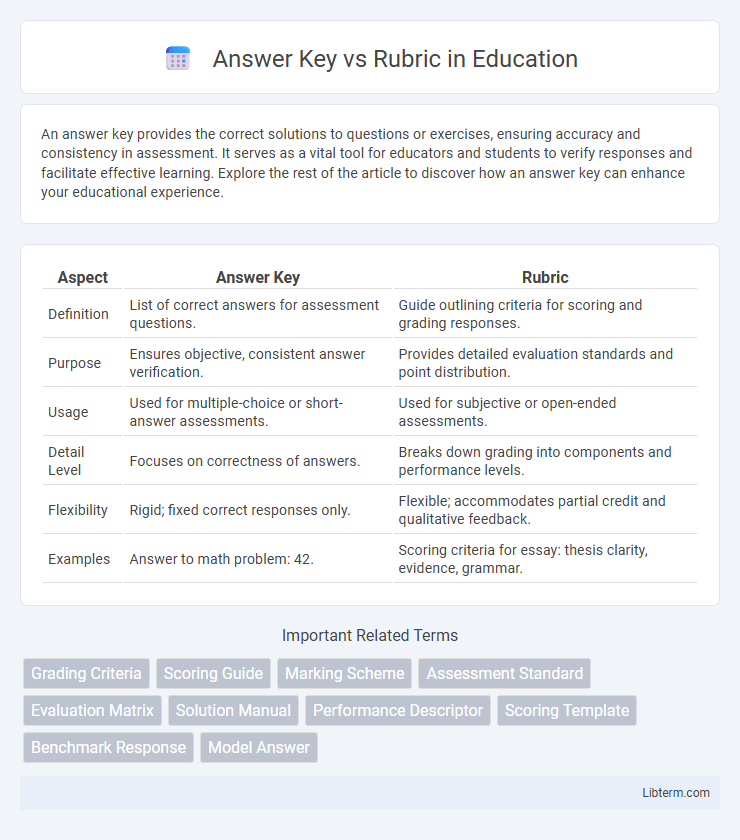An answer key provides the correct solutions to questions or exercises, ensuring accuracy and consistency in assessment. It serves as a vital tool for educators and students to verify responses and facilitate effective learning. Explore the rest of the article to discover how an answer key can enhance your educational experience.
Table of Comparison
| Aspect | Answer Key | Rubric |
|---|---|---|
| Definition | List of correct answers for assessment questions. | Guide outlining criteria for scoring and grading responses. |
| Purpose | Ensures objective, consistent answer verification. | Provides detailed evaluation standards and point distribution. |
| Usage | Used for multiple-choice or short-answer assessments. | Used for subjective or open-ended assessments. |
| Detail Level | Focuses on correctness of answers. | Breaks down grading into components and performance levels. |
| Flexibility | Rigid; fixed correct responses only. | Flexible; accommodates partial credit and qualitative feedback. |
| Examples | Answer to math problem: 42. | Scoring criteria for essay: thesis clarity, evidence, grammar. |
Introduction to Answer Keys and Rubrics
Answer keys provide exact solutions or correct responses to assessment items, allowing for straightforward grading based on predetermined answers. Rubrics offer detailed criteria that describe varying levels of performance quality, guiding evaluators in assessing complex or subjective tasks. Both tools ensure consistent and objective evaluation but serve distinct purposes in educational assessment.
Defining Answer Key: Purpose and Structure
An answer key serves as a definitive guide outlining correct responses to assessment questions, ensuring consistency and accuracy in grading. It typically includes concise, precise answers matched to specific questions, emphasizing clarity and objectivity. The structured format of an answer key aids educators in quickly verifying student submissions against established standards for objective assessments.
What Is a Rubric? Key Features
A rubric is a scoring guide used to evaluate performance, assignments, or assessments based on specific criteria and standards. Key features of a rubric include clearly defined assessment categories, detailed performance levels, and descriptive criteria that outline expectations for each level of achievement. Rubrics enhance grading consistency, provide transparent feedback, and help both educators and students understand how scores are assigned.
Differences Between Answer Keys and Rubrics
Answer keys provide specific correct answers for objective questions, ensuring consistency in grading factual responses. Rubrics outline detailed criteria and performance levels for subjective assessments, guiding evaluators on how to score based on quality and components of student work. The primary difference lies in answer keys being answer-specific while rubrics assess the process and quality of responses.
When to Use an Answer Key
An answer key is ideal for objective assessments such as multiple-choice, true/false, or fill-in-the-blank tests where specific correct responses are predetermined. Use an answer key when grading requires quick, consistent evaluation without subjective interpretation, ensuring uniformity across all student submissions. This tool streamlines the scoring process, saving time and enhancing accuracy in standardized testing environments.
When to Use a Rubric
Use a rubric when assessing complex assignments that require evaluating multiple criteria such as creativity, organization, and comprehension, ensuring consistent and transparent grading. Rubrics provide detailed performance indicators that guide both instructors and students on expectations and achievement levels. This method improves feedback quality and supports objective assessment in qualitative and project-based tasks.
Advantages of Using Answer Keys
Answer keys provide a clear and consistent method for scoring assessments, ensuring quick and objective grading that minimizes human error. They enable educators to efficiently evaluate student responses against correct solutions, improving accuracy and standardization in grading. Using answer keys also supports timely feedback, allowing students to understand their mistakes and learn from them promptly.
Benefits of Employing Rubrics
Employing rubrics enhances assessment clarity by providing detailed criteria that guide consistent and objective grading, reducing subjectivity and bias. Rubrics facilitate transparent communication of expectations to students, promoting self-assessment and targeted improvement. They streamline feedback delivery, saving educators time while supporting more effective learning outcomes through structured evaluation.
Common Mistakes in Using Answer Keys and Rubrics
Common mistakes when using answer keys include relying solely on them for grading without considering partial credit or understanding student reasoning, leading to unfair assessments. Rubric misuse often involves applying generic criteria that do not align closely with the specific learning objectives or assignment requirements, resulting in inconsistent and subjective scores. Proper calibration of rubrics and integrating flexible evaluation with answer keys enhances accuracy and fairness in educational assessments.
Choosing the Right Assessment Tool for Your Needs
Choosing between an answer key and a rubric depends on the assessment's objectives: answer keys provide straightforward right-or-wrong responses ideal for objective grading, while rubrics offer detailed criteria for evaluating complex skills and subjective tasks. Rubrics enhance consistency and transparency by outlining performance levels, helping educators give nuanced feedback and support student growth. Selecting the appropriate tool ensures alignment with learning goals, whether measuring accuracy or assessing critical thinking and creativity.
Answer Key Infographic

 libterm.com
libterm.com